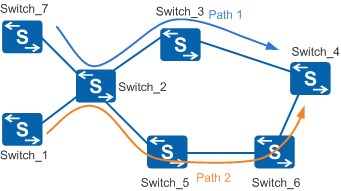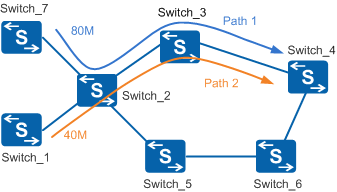Overview of MPLS TE
Definition
Multiprotocol Label Switching Traffic Engineering (MPLS TE) establishes constraint-based routed label switched paths (CR-LSPs) and directs traffic to them. In this way, network traffic is transmitted over specified paths.
Purpose
On a traditional IP network, nodes select the shortest path as the route to a destination regardless of other factors such as bandwidth. This routing mechanism may cause congestion on the shortest path and waste resources on other available paths, as shown in Figure 1.
On the network shown in Figure 1, each link has a bandwidth of 100 Mbit/s and the same metric. Switch_1 sends traffic to Switch_4 at 40 Mbit/s, and Switch_7 sends traffic to Switch_4 at 80 Mbit/s. If the network runs an interior gateway protocol (IGP) that uses the shortest path mechanism, both the two shortest paths (Path 1 and Path 2) pass through the link Switch_2->Switch_3->Switch_4. As a result, the link Switch_2->Switch_3->Switch_4 is overloaded, whereas the link Switch_2->Switch_5->Switch_6->Switch_4 is idle.
Traffic engineering can prevent congestion caused by uneven resource allocation by allocating some traffic to idle links.
IP TE: This mechanism adjusts path metrics to control traffic transmission paths. It prevents congestion on some links but may cause congestion on other links. In addition, path metrics are difficult to adjust on a complex network because any change on a link affects multiple routes.
Asynchronous Transfer Mode (ATM) TE: All IGPs select routes based only on connections and cannot distribute traffic based on bandwidth and the traffic attributes of links. The IP over ATM overlay model can overcome this defect by setting up virtual links to transmit some traffic, which helps ensure proper traffic distribution and good QoS control. However, ATM TE causes high extra costs and low scalability on the network.
What is needed is a scalable and simple solution to deploy TE on a large backbone network. MPLS TE is an ideal solution. As an overlay model, MPLS can set up a virtual topology over a physical topology and map traffic to the virtual topology.

Benefits
MPLS TE fully uses network resources and provides bandwidth and QoS guarantee without the need to upgrade hardware. This significantly reduces network deployment costs. MPLS TE is easy to deploy and maintain because it is implemented based on MPLS. In addition, MPLS TE provides various reliability mechanisms to ensure network and device reliability.
This chapter describes how to configure MPLS TE tunnels that transmit MPLS L2VPN services and MPLS L3VPN services and provide high security and guarantees reliable QoS for VPN services.
